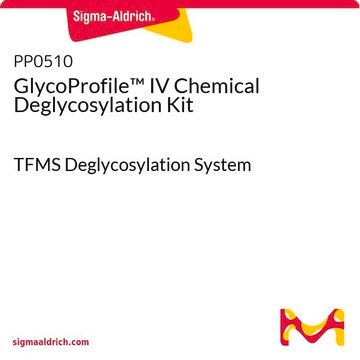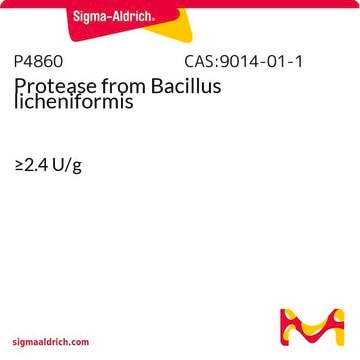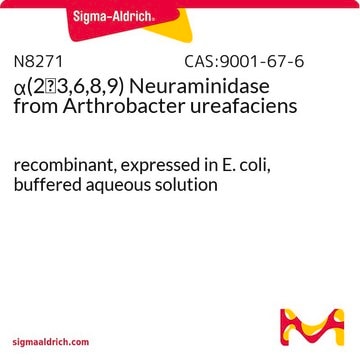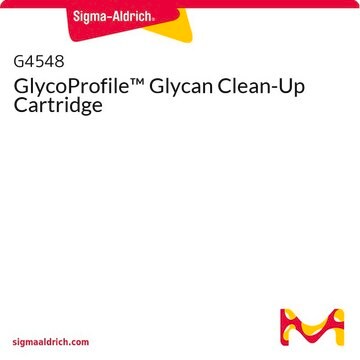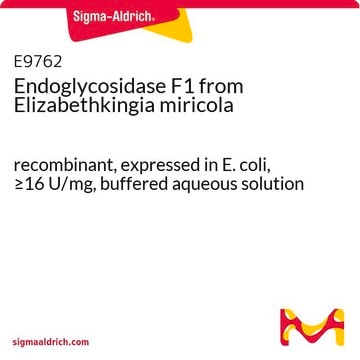EDEGLY
Enzymatic Protein Deglycosylation Kit
Synonym(s):
Glycosylation Release Kit
Sign Into View Organizational & Contract Pricing
All Photos(1)
About This Item
UNSPSC Code:
12352202
NACRES:
NA.32
Recommended Products
General description
Enzymatic protein deglycosylation kit contains all the enzymes and reagents required for the complete removal of N-linked and simple O-linked carbohydrates from glycoproteins. This kit is employed to cleave the complex Core 2 O-linked carbohydrates including those containing polylactosamine.
Application
Enzymatic Protein Deglycosylation Kit has been used for the deglycosylation of various enzymes.
Enzymatic protein deglycosylation kit has been used in:
- protein deglycosylation
- deglycosylation of tissue factor pathway inhibitor (TFPI) α and β
- deglycosylation of native exo-β-(1,3)-glucanase EXG1
Features and Benefits
Enzymatic protein deglycosylation kit has the following features:
- two or more mg of glycoprotein is deglycosylated
- single reaction at neutral pH
- native & denaturing procedures
- no degradation of protein
- O-linked sugars containing polysialic acid are eliminated
- control glycoprotein provided
Kit Components Only
Product No.
Description
- PNGase F 1 mL/vial
- O-Glycosidase 20 μL
- α-2(3,6,8,9)-Neuraminidase 20 μL
- Fetuin Control .5 mg
- 5× Reaction Buffer .2 mL
- Denaturation Solution .1 mL
- Triton™ X-100 .1 mL
- β-1→4-Galactosidase, positionally specific 20 μL
- β-N-Acetylglucosaminidase 20 μL
See All (9)
related product
Product No.
Description
Pricing
Signal Word
Danger
Hazard Statements
Precautionary Statements
Hazard Classifications
Acute Tox. 4 Dermal - Acute Tox. 4 Oral - Aquatic Acute 1 - Aquatic Chronic 2 - Eye Dam. 1 - Repr. 2 - Resp. Sens. 1 - Skin Irrit. 2 - Skin Sens. 1
Storage Class Code
10 - Combustible liquids
Flash Point(F)
Not applicable
Flash Point(C)
Not applicable
Choose from one of the most recent versions:
Already Own This Product?
Find documentation for the products that you have recently purchased in the Document Library.
Customers Also Viewed
Primavera Alvarado et al.
Journal of microbiological methods, 175, 105981-105981 (2020-06-15)
The diagnosis of histoplasmosis depends on various approaches: direct clinical examination, fungus isolation from cultures of clinical samples, histopathological evaluation, and serological testing. In serodiagnostic assays, the Histoplasma capsulatum H and M antigenic glycoproteins have been extensively used. However, both
Guillermo Bernabó et al.
PloS one, 8(7), e71192-e71192 (2013-08-08)
Among the several multigene families codified by the genome of T. cruzi, the TcTASV family was the latest discovered. The TcTASV (Trypomastigote, Alanine, Serine, Valine) family is composed of ∼40 members, with conserved carboxi- and amino-termini but with a variable
Scabies mite peritrophins are potential targets of human host innate immunity
Mika A, et al.
PLoS Neglected Tropical Diseases, 5(9), e1331-e1331 (2011)
Misun Park et al.
Scientific reports, 7(1), 7890-7890 (2017-08-13)
β1-adrenergic receptors (β1ARs) mediate catecholamine actions in cardiomyocytes by coupling to both Gs/cAMP-dependent and Gs-independent/growth-regulatory pathways. Structural studies of the β1AR define ligand-binding sites in the transmembrane helices and effector docking sites at the intracellular surface of the β1AR, but
Identification of histoplasma-specific peptides in human urine
Crockett DK, et al.
International Journal of Peptides, 2012 (2012)
Our team of scientists has experience in all areas of research including Life Science, Material Science, Chemical Synthesis, Chromatography, Analytical and many others.
Contact Technical Service

